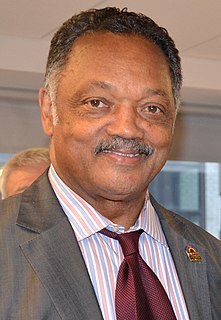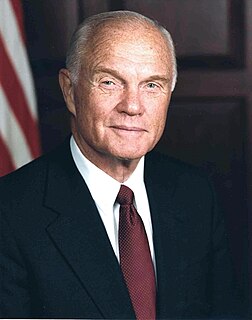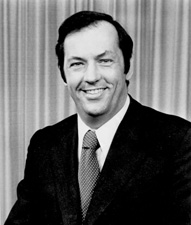
The 1988 United States presidential election was the 51st quadrennial United States presidential election. It was held on Tuesday, November 8, 1988. Incumbent Vice President George H. W. Bush, the Republican nominee, defeated Democratic Governor Michael Dukakis of Massachusetts. The 1988 election is the only election since 1948 in which either major party won a third straight presidential election.

The 1984 United States presidential election was the 50th quadrennial presidential election. It was held on Tuesday, November 6, 1984. Incumbent Republican President Ronald Reagan defeated former Vice President Walter Mondale, the Democratic candidate.
The 1988 National Convention of the U.S. Democratic Party was held at The Omni in Atlanta, Georgia, from July 18–July 21, 1988, to select candidates for the 1988 presidential election. At the convention Governor Michael Dukakis of Massachusetts was nominated for President and Senator Lloyd Bentsen of Texas for Vice President. The chair of the convention was Speaker of the U.S. House of Representatives Jim Wright.

The 1988 United States Senate elections was an election for the United States Senate in which, in spite of the Republican victory by George H. W. Bush in the presidential election, the Democrats gained a net of one seat in the Senate. Seven seats changed parties, with four incumbents being defeated. The Democratic majority in the Senate increased by one from 54/46 to 55/45.
The 1988 presidential campaign of Al Gore, U.S. Senator of Tennessee and former House Representative began on April 11, 1987. He campaigned for President of the United States as a Democratic candidate in the 1988 presidential election, against Democratic candidates Joe Biden, Dick Gephardt, Paul Simon, Jesse Jackson, and Michael Dukakis. Despite eventual defeat, Gore was one of the front-runners that year. Al Gore, at that time, represented the Southern Democrats and some of the Conservative Democrats in 1980s.
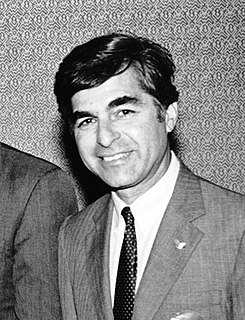
The 1988 Democratic presidential primaries were the selection process by which voters of the Democratic Party chose its nominee for President of the United States in the 1988 U.S. presidential election. Massachusetts Governor Michael Dukakis was selected as the nominee through a series of primary elections and caucuses culminating in the 1988 Democratic National Convention held from July 18 to July 21, 1988, in Atlanta, Georgia. This is also the last time Illinois, Missouri, Virginia, Georgia, Alabama, Mississippi, and Louisiana chose delegates for a candidate who did not win the nomination.

The 1988 United States Senate election in Texas was held on November 8, 1988. Incumbent Democratic U.S. Senator Lloyd Bentsen won re-election to a fourth term, defeating Republican Representative Beau Boulter.
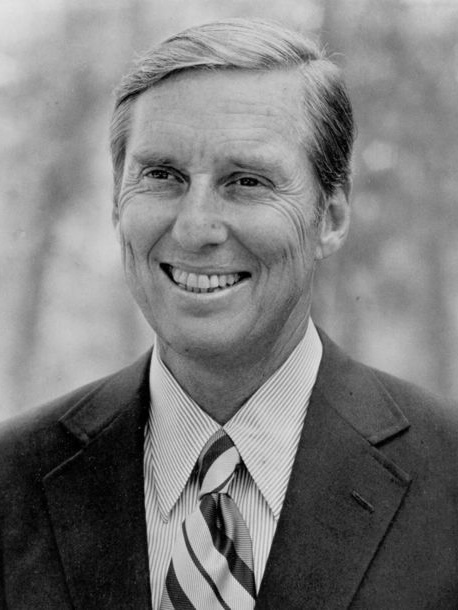
The 1970 United States Senate election in Texas was held on November 3, 1970. Incumbent Democratic U.S. Senator Ralph Yarborough was defeated by former Representative Lloyd Bentsen in the Democratic primary. Bentsen then defeated Representative George H.W. Bush in the general election. When Bush was running for President in 1988, his Democratic opponent, Massachusetts Governor Michael Dukakis, selected Bentsen as his vice presidential running mate.
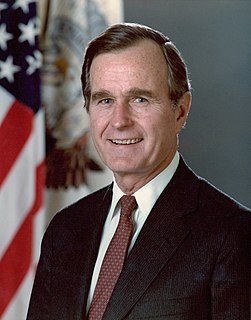
The 1988 United States presidential election in Alabama took place on November 8, 1988. All fifty states and the District of Columbia, were part of the 1988 United States presidential election. Alabama voters chose nine electors to the Electoral College, which selected the president and vice president.

The 1988 United States presidential election in Alaska took place on November 8, 1988. All 50 states and the District of Columbia, were part of the 1988 United States presidential election. Alaska voters chose 3 electors to the Electoral College, which selected the president and vice president.

The 1988 United States presidential election in Delaware took place on November 8, 1988. All 50 states and the District of Columbia, were part of the 1988 United States presidential election. Delaware voters chose 3 electors to the Electoral College, which selected the president and vice president.

The 1988 United States presidential election in New Jersey took place on November 8, 1988. All 50 states and the District of Columbia, were part of the 1988 United States presidential election. New Jersey voters chose 16 electors to the Electoral College, which selected the president and vice president.

The 1988 United States presidential election in West Virginia took place on November 8, 1988. All 50 states and the District of Columbia were part of the 1988 United States presidential election. West Virginia voters chose 6 electors to the Electoral College, which selected the president and vice president.

The 1988 United States presidential election in Wisconsin took place on November 8, 1988. All 50 states and the District of Columbia, were part of the 1988 United States presidential election. Wisconsin voters chose 11 electors to the Electoral College, which selected the president and vice president.

This article lists those who were potential candidates for the Democratic nomination for Vice President of the United States in the 1992 election. Arkansas Governor Bill Clinton won the 1992 Democratic nomination for President of the United States, and chose Tennessee Senator Albert Gore, Jr. as his running mate on July 9, 1992. Clinton considered roughly forty different candidates for vice president, including those who did not hold elective office, but Clinton ultimately chose Gore, a two-term Senator who had previously run for president in 1988. Former Assistant Secretary of State Warren Christopher led Clinton's vice presidential selection team. In making the selection, Clinton emphasized Gore's experience with foreign policy and environmental issues. Clinton's choice of a fellow young southern centrist defied conventional wisdom, but the choice of Gore was well-received, and Gore made an effective surrogate on the campaign trail. The Clinton-Gore ticket ultimately defeated the Republican Bush-Quayle ticket and the independent Perot-Stockdale ticket, and the Clinton-Gore duo became the youngest ticket in history to win a presidential election.

This article lists those who were potential candidates for the Republican nomination for Vice President of the United States in the 1988 election. Incumbent Vice President George H.W. Bush won the 1988 Republican nomination for President of the United States, and chose Indiana Senator Dan Quayle as his running mate. The selection of Quayle surprised many of Bush's closest advisers, who had expected Bush to pick a more well-known running mate. However, Bush adviser Roger Ailes helped convince Bush that Quayle would be able to effectively attack the Democratic presidential nominee, Michael Dukakis. Bush also liked Quayle's youth and felt that Quayle would make for a loyal vice president. The Bush-Quayle ticket ultimately defeated the Dukakis-Bentsen ticket in the 1988 election.
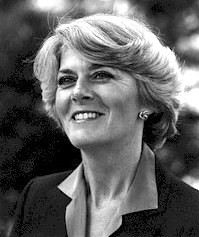
This article lists those who were potential candidates for the Democratic nomination for Vice President of the United States in the 1984 election. Former Vice President Walter Mondale won the 1984 Democratic nomination for President of the United States, and chose New York Representative Geraldine Ferraro as his running mate. Ferraro was the first woman to be a part of a national ticket for a major party. Mondale chose Ferraro in hopes of energizing the base and winning the votes of women, but also because he viewed her as a solid legislator who had won the approval of Speaker Tip O'Neill. John R. Reilly, an attorney and a senior adviser to Mondale, managed the search for a running mate. Mondale seriously considered his major rival for the 1984 presidential nomination, Senator Gary Hart, but Mondale refused to consider a second rival, Jesse Jackson, on the grounds that the differences between their policies were too great. The Mondale-Ferraro ticket ultimately lost to the Reagan-Bush ticket.

This article lists those who were potential candidates for the Republican nomination for Vice President of the United States in the 1980 election. Former California Governor Ronald Reagan won the 1980 Republican nomination for President of the United States, and chose former Texas Representative George H. W. Bush as his running mate. Reagan had considered naming former president Gerald Ford as his running mate, but after Ford and Reagan were unable to agree to be on the same ticket, Reagan turned to Bush, his primary rival for the 1980 Republican nomination. Though Bush had criticized Reagan's policies, Reagan chose Bush to help unify the party, and Bush agreed to be on the ticket and to support Reagan's platform. The Reagan-Bush ticket defeated the incumbent Democratic Carter-Mondale ticket, and in 1984 won re-election defeating the Mondale-Ferraro ticket. Bush was later elected president in his own right in 1988.

The 1988 presidential campaign of Michael Dukakis began when he announced his candidacy for the Democratic Party's 1988 presidential nomination on March 16, 1987, in a speech in Boston. After winning the nomination, he was formally crowned the Democratic Party's nominee at the party's convention in Atlanta, Georgia on July 21, 1988. He lost the 1988 election to his Republican opponent George H. W. Bush, who was the sitting Vice President at the time. Dukakis won 10 states and the District of Columbia, receiving a total of 111 electoral votes compared to Bush's 426. Dukakis received 46% of the popular vote to Bush's 54%. Many commentators blamed Dukakis' loss on the embarrassing photograph of him in a tank taken on September 13, 1988, which subsequently formed the basis of a successful Republican attack ad. Much of the blame was also laid on Dukakis' campaign, which was criticized for being poorly managed despite being well funded.




